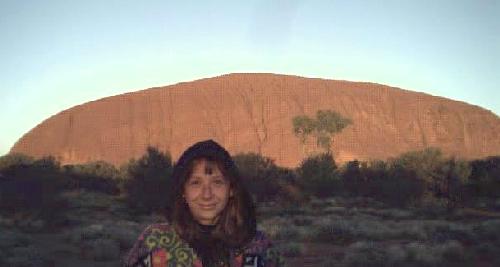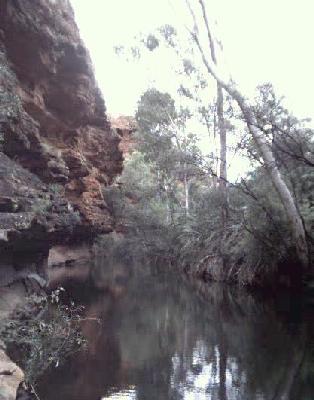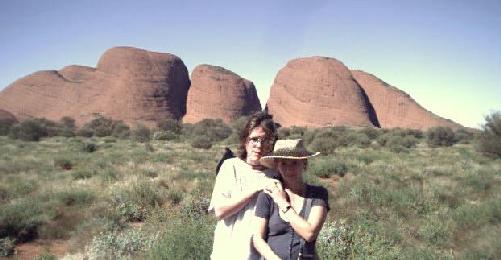
Australia part five
Adelaide - Alice Springs
26th April - 8th May 2000

Camels ho!
From Adelaide we started our trip north, moving slowly homewards, with a short drive to the Barossa Valley. This valley is one of the main centres of the Australian wine industry - there are over 40 wineries in a very small area. We stopped off to buy a range of wines for tasting before arriving at the Old Marananga School Backpackers. Evidently a former girls school, on arrival you're directed to claim a bed, drop off your bags, and then put on an old school uniform, for reasons not entirely clear to me for one. We then proceeded with the wine tasting. I know I'm harking on an old theme here, but I've yet to come across an Australian wine that really grabs me and says "I am great, drink me!" in the way that a Lisjak Cabernet Sauvignon 93 did the first time I tried it. Am I getting homesick for Slovene wine? I think so!
As was almost bound to happen after a decent wine tasting, the evening turned into a bit of a sesh. The next day, nursing our mild hangovers, we were "delighted" to discover that the area had become a victim of a plague of locusts - all the way along the road for hours and hours there were swarms of locusts making a considerable splatting noise as they wiped out on the windscreen. By the time we eventually got to Hawker, which was our pit-stop, the windscreen was a mess, and the metal grille protecting the lower half of the window from stray stones was covered in a two-deep layer of dead and dying locusts. We were all icking and yeching when Scott, one of the guys working at the petrol station where we stopped, simply started scraping them off with his hands, not before we'd asked him to wait while we all took photos of the day's casualties. I'm not sure if they're used to tourists in Hawker, but whether they are or not, I'm fairly confident they must think that we're weird. Mind you, I reckon having a rideable vacuum cleaner to suck up the shredded corpses of roadkill locusts is pretty weird, so the feeling is probably mutual.
The rest of the day was spent driving along dirt roads through the lower Flinders Ranges. We stopped off to hug a giant red river gum, reputed to be over 500 years old, before checking out the sunset over the mountains - very colourful. Our stop for the night was at Parachilna, which is basically a hotel built in a converted railway station. Depending on who you believe, the official population is either five or six, so you can imagine that it's a bit on the isolated side. More locusts here, including a closer encounter with one in the bathroom than I ever want to have again - I won't go into details here, as this is a family page.

South Australian sunset
Next morning we headed off again through the Flinders Ranges, and this time we saw a variety of wildlife - several different types of kangaroo/wallaby, including the Euro. a sort of cross between the two, as well as several families of emus and a number of camels. In a very coals-to-Newcastle sort of way, the Australians export camels to Saudi Arabia. They were originally brought over to Australia with Afghani riders to serve as a freight service through the centre of the country. When the train was built (named in fact the Ghan in memory of the camel drovers), the bottom fell out of the camel freight business and the Afghanis released them to fend for themselves. Today there are estimated to be around 200,000 wild camels in the outback, and because they are a pure variety with little or no disease, they are in big demand in the Middle East for camel racing, whence the unusual Australian export market. We then continued on through the desolate Aroona Valley, stopping only to check out the scenery and for the odd group photo (with 22 cameras, group photos can take quite some time).
It was then time to go to Wilpena Pound. This is an old volcanic crater some twelve by eight kilometres, with one narrow entrance into the middle. Despite our poor timing (arriving at noon, just as the mid-day sun was starting to kick in), most of us opted to go for a walk up to a lookout, and although not very high, the heat was exhausting, and it was a tired bunch of travellers who straggled up to the top. As usual, though, it was worth it, as the views from the top were spectacular, and I can't remember water ever tasting so good as the swig I took from my bottle when we finally managed to sit down. The trip back down was a pleasant stroll by comparison, although I was soaking by the time we hit the base again.
From Wilpena Pound it was time to go visit some caves, or rather one cave. The main point was not to see the caves per se, but to check out the Aboriginal rock art painted inside at Yourambulla. The paintings were interesting but not spectacular, although the setting was pretty good, and for once they provided a sign explaining some of the symbolism involved (a lot of sites/museums in Australia seem to go for the minimalist approach when it comes to labelling, presumably because they want to sell you guidebooks with more information at a cost. In particular, I felt a lack of information in the Pacific Islands Cultures Room in Adelaide, although the designs and sheer brilliance of some of the decorations were in many cases sufficient.)
Our overnight stop came in Quorn, a small town and not a mushroom-based meat substitute. We stayed at the pleasant (although crowded) YHA hostel, eating one of our by-now standard meals of soup and sandwiches before being persuaded to head down to the pub for one (ha!) beer. There was a whole crowd of people there, so we played some pool (in my case badly) and drank several beers and generally had a good time. Towards the end of the evening, Homer, one of the OzEx drivers, left me a large chunk of a bottle of port, so that was me for the rest of the night. We even had planned to do a mini-pub-crawl, except that two of the four pubs in town were closed by the time the idea came to us. Ah well.
Next day was a long day's drive to Coober Pedy, with few stops. One place we did stop was at Woomera (which cleverly means "throwing sticks" in the local aboriginal dialect). Woomera is the site of the joint Australian-US missile testing range, and as such is a closed territory. Straying off the road will lead you directly to jail with a $10,000 dollar fine to boot. As you might imagine, none of us opted for this alternative extension of our holidays.
Our next brief stop was at Glendambo for lunch; the main attraction in this place was the amusing sign at the start of the town. Having eaten our lunch on the veranda of the service station, I contrived to leave my camera there, and failed to notice this until we were a couple of hundred kilometres further up the road. By the time we'd reached Coober Pedy and checked in at our hostel, the very kind people at the petrol station had already phone ahead to our hostel, and then arranged to put my camera on the next Greyhound bus, which was due to arrive in Coober Pedy a couple of hours before we were due to leave in the morning, so I actually only missed my camera for around twelve hours.

Obligatory Uluru photograph
It was then a long empty drive, made more interesting by a rather unusual game. All through the desert areas of this part of Australia, a little plant grows called a paddy melon. The fruit looks like melons, but are about the size of large tomatoes. They're not good to eat, but they are particularly good for throwing at road signs, so we gathered up several hundred melons and attempted to pass the time by attacking poor innocent road signs for a couple of hundred kilometres.
As if that wasn't strange enough, we soon afterwards got into Coober Pedy. A weird, other-worldly place, Coober Pedy is the centre of Australia's opal mining industry, and is just downright odd. They've even carved out a golf course from the bare rock and dust, and this is probably the only course in the world where they have browns instead of greens.
The whole area was declared a gem field, which apparently has the effect of keeping out industrial-scale mining to give the little guy a fair chance, and because the heat gets unbearable (temperatures above 50C - 122F - have been recorded), many people choose to hollow out their houses from the bare rock. Indeed Radeka's, the hostel where we were staying, is underground. This being Australia, the pub across the road boasted what they claimed were the world's only underground "pokies" (poker machines). We went for a town tour, which I felt was rather disappointing, especially since the legendary Crocodile Harry (an ex-crocodile-hunter Latvian baron turned opal miner and lecherous tourist attraction in his own right) had just hospitalised himself the night before, although we did get the opportunity to go "noodling" which for some reason is the term given to searching through piles of stones looking for opals. I even managed to find some small, basically worthless, opals, including one which had a beautiful shade of blue-green.
From Coober Pedy, it was a long straight drive to Alice, the perfect way to prove if there was any doubt left that Australia really is a bloody big place. We stopped off to check out some views, and also because we saw a very curious and cute dingo watching us from a safe distance but close to (and in fact on the wrong side of) the legendary dingo fence, all 5300 kilometres of it. Evidently it's not working too well. In Alice we checked into our hostel then went into town for dinner and a few drinks with the rest of the group. Inevitably, a fairly epic night ensued, followed by a completely not-epic day, with just about the only activity being arranging our trip to Ayer's Rock (Uluru), the Olgas and King's Canyon.
We explored Alice a bit, but to be perfectly honest there's not a great deal to see. Based solely on reading Nevil Shute's A Town Like Alice and watching the film, I had expected a small, quiet outback town with a bit of character and a lot of charm. Instead what we got was a small outback town revolving apparently entirely around tourism. There's not a great deal to do if you're not shopping for souvenirs or eating out. Still the hostel we were staying in was quite pleasant and very peaceful, so we were quite happy to do nothing.

Water hole in King's Canyon
On Thursday (4th May) we set out on our tour of the main attractions of the centre. First stop was a couple of hundred kilometres down the road at the famous Noel Fullerton's Camel Farm. There we had a cup of coffee (we'd left Alice before 6 in the morning) and went for a short ride on a camel - quite fun, but the constant undulations can be a bit wearing, particularly for men!
Next stop was the beautiful King's Canyon, or as it is known by the local Aborigines, Watarrka. Formed when the centre of Australia was under water (difficult to imagine these days, given how dry the climate usually is), the soft sandstone has been eroded into spectacular formations and deep valleys, with sheer cliffs over 100 metres straight down. The area is of course predominantly dry, but there are permanent water sources, and a couple of waterholes where the water is clean and clear, albeit very cold. It's surreal to walk through an arid rocky landscape, then descend into a hidden valley (this being Australia, they've made it easier by building large wooden steps all the way down, with banisters and all) with luscious growth and even date palms. Little wonder this place is known as the Garden of Eden.
Our first night camping was a little strange. I'm willing to assume that the reasons lay in the recent heavy rains and the consequent flooding, but my idea of bush camping is not lying on the grass of a petrol station-cum-pub. One of the reasons we wanted to go on a camping tour to the Rock was that we wanted to get out into the middle of nowhere. At Curtin Springs, however, we were constantly disturbed by the trucks coming in to refuel, and although we had facilities to hand, such as toilets and a pub, this was not what we had expected or even wanted. Also the lights from the petrol station meant that for the most part we couldn't lie back and watch the stars. I also suffered from an incipient cold, which made it very difficult for me to catch any sleep, since the moment I laid my head back my nose started running and I couldn't breathe. I had a very unpleasant night before being woken up while it was still dark.
Our next stop was the Olgas, more properly known as Kata Tjuta, meaning "many heads". To my mind, this was a much more alluring place than Ayer's Rock (Uluru), and indeed Kata Tjuta was more culturally significant to the local people (the Anangu) than Uluru. The area consists of a series of red domes with rolling valleys running between them. Large areas of Kata Tjuta are off-limits to everyone but initiated Anangu, but we were able to go for a 10 kilometre stroll through to the very aptly named Valley of the Winds.

Two more heads to be added to Kata Tjuta
From the Olgas we passed on to Uluru for sunset. It's a very strange experience being among the crowds (hundreds of people, mostly in large bus groups) standing watching a big rock a long way away, but basically you had to be there. It's only occasionally that the sunset is as spectacular as in the photos from the tourist brochures, but the rock really does change colour.
We then had dinner overlooking the rock from the car park, to the accompaniment of an Israeli disco-bus - things just kept getting stranger. After dinner we drove on to our next overnight stop, somewhere unnamed on a large cattle station. We were again up very early the next morning to drive back to Uluru for sunrise, basically the previous evening's colour changes in reverse. The peace of the moment was only temporarily shattered by an obnoxious American women who seemed to think that she had the right to monopolise one of the better areas for viewing the sunrise from the comfort of her car. Obviously used to getting her own way, she was stunned into silence by our refusal to move on, despite the fact that we were not in any way blocking her view. Fortunately nobody let this get us down, and we continued to ooh and aah at the sunrise while trying to avoid shivering too much to keep our cameras straight.
After breakfast, which we nearly missed because nobody had bothered to tell us it was ready (this was a bit of a sore point throughout the tour - we kept on missing out on food because other people had taken too much), we drove on to the Cultural Centre, where there was an interesting if uninspired display about the local Anangu people and their traditional attachment to the landscape in general and to Uluru in particular. Specifically, the Anangu rarely climb the rock; only initiated men do so on certain specific occasions. They also actively discourage tourists from climbing the rock, although this doesn't seem to bother the huge numbers of people who traipse off their air-con coaches straight up the rock without giving any consideration for the traditional owners. After much consideration, we decided to opt for a base walk instead. This was a very good choice, as it gave us the chance to see all areas of the rock, and also demonstrated (if we still needed convincing) that it really is a big rock - the walk around is about 10 kilometres. From a distance, Uluru looks like a uniform red blob; close up, it is surprisingly varied - there are even permanent water sources and pools in various places, and when you're in the shade the temperature can dip quite suddenly - we were constantly taking off and putting back on our jackets/jumpers.
After the walk, it was back to the Curtin Springs station for lunch, and then the long drive back to Alice Springs. By the time we got back, I was so exhausted I only had time for a cup of extra-strong lemon tea before passing out.
Previous | Next | Travel index | Family history | Romany | Main index